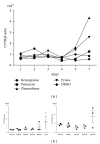Profiling of biomarkers for the exposure of polycyclic aromatic hydrocarbons: lamin-A/C isoform 3, poly[ADP-ribose] polymerase 1, and mitochondria copy number are identified as universal biomarkers
- PMID: 25114913
- PMCID: PMC4121044
- DOI: 10.1155/2014/605135
Profiling of biomarkers for the exposure of polycyclic aromatic hydrocarbons: lamin-A/C isoform 3, poly[ADP-ribose] polymerase 1, and mitochondria copy number are identified as universal biomarkers
Abstract
This study investigated the profiling of polycyclic aromatic hydrocarbon- (PAH-) induced genotoxicity in cell lines and zebrafish. Each type of cells displayed different proportionality of apoptosis. Mitochondrial DNA (mtDNA) copy number was dramatically elevated after 5-day treatment of fluoranthene and pyrene. The notable deregulated proteins for PAHs exposure were displayed as follows: lamin-A/C isoform 3 and annexin A1 for benzopyrene; lamin-A/C isoform 3 and DNA topoisomerase 2-alpha for pentacene; poly[ADP-ribose] polymerase 1 (PARP-1) for fluoranthene; and talin-1 and DNA topoisomerase 2-alpha for pyrene. Among them, lamin-A/C isoform 3 and PARP-1 were further confirmed using mRNA and protein expression study. Obvious morphological abnormalities including curved backbone and cardiomegaly in zebrafish were observed in the 54 hpf with more than 400 nM of benzopyrene. In conclusion, the change of mitochondrial genome (increased mtDNA copy number) was closely associated with PAH exposure in cell lines and mesenchymal stem cells. Lamin-A/C isoform 3, talin-1, and annexin A1 were identified as universal biomarkers for PAHs exposure. Zebrafish, specifically at embryo stage, showed suitable in vivo model for monitoring PAHs exposure to hematopoietic tissue and other organs.
Figures







Similar articles
-
Polycyclic aromatic hydrocarbons exposure decreased sperm mitochondrial DNA copy number: A cross-sectional study (MARHCS) in Chongqing, China.Environ Pollut. 2017 Jan;220(Pt A):680-687. doi: 10.1016/j.envpol.2016.10.026. Epub 2016 Oct 15. Environ Pollut. 2017. PMID: 27751638
-
Decreased mitochondrial DNA content in association with exposure to polycyclic aromatic hydrocarbons in house dust during wintertime: from a population enquiry to cell culture.PLoS One. 2013 May 3;8(5):e63208. doi: 10.1371/journal.pone.0063208. Print 2013. PLoS One. 2013. PMID: 23658810 Free PMC article.
-
Seasonal modification of the associations of exposure to polycyclic aromatic hydrocarbons or phthalates of cellular aging.Ecotoxicol Environ Saf. 2019 Oct 30;182:109384. doi: 10.1016/j.ecoenv.2019.109384. Epub 2019 Jul 1. Ecotoxicol Environ Saf. 2019. PMID: 31272023
-
Molecular epidemiology studies of carcinogenic environmental pollutants. Effects of polycyclic aromatic hydrocarbons (PAHs) in environmental pollution on exogenous and oxidative DNA damage.Mutat Res. 2003 Nov;544(2-3):397-402. doi: 10.1016/j.mrrev.2003.09.002. Mutat Res. 2003. PMID: 14644342 Review.
-
Modulating poly (ADP-ribose) polymerase activity: potential for the prevention and therapy of pathogenic situations involving DNA damage and oxidative stress.Curr Pharm Biotechnol. 2002 Sep;3(3):275-83. doi: 10.2174/1389201023378265. Curr Pharm Biotechnol. 2002. PMID: 12164482 Review.
Cited by
-
DNA methylation of the cancer-related genes F2RL3 and AHRR is associated with occupational exposure to polycyclic aromatic hydrocarbons.Carcinogenesis. 2018 Jul 3;39(7):869-878. doi: 10.1093/carcin/bgy059. Carcinogenesis. 2018. PMID: 29722794 Free PMC article.
-
Potential biomarkers and antagonists for fluoranthene-induced cellular toxicity of bone marrow derived mesenchymal stem cells.Blood Res. 2019 Dec;54(4):253-261. doi: 10.5045/br.2019.54.4.253. Epub 2019 Dec 20. Blood Res. 2019. PMID: 31915651 Free PMC article.
-
Hyaluronic acid-graphene oxide quantum dots nanoconjugate as dual purpose drug delivery and therapeutic agent in meta-inflammation.J Nanobiotechnology. 2023 Aug 1;21(1):246. doi: 10.1186/s12951-023-02015-w. J Nanobiotechnology. 2023. PMID: 37528408 Free PMC article.
-
Occupational exposure to asphalt mixture during road paving is related to increased mitochondria DNA copy number: a cross-sectional study.Environ Health. 2018 Mar 27;17(1):29. doi: 10.1186/s12940-018-0375-0. Environ Health. 2018. PMID: 29587765 Free PMC article.
-
Air pollutants and early origins of respiratory diseases.Chronic Dis Transl Med. 2018 Jun 7;4(2):75-94. doi: 10.1016/j.cdtm.2018.03.003. eCollection 2018 Jun. Chronic Dis Transl Med. 2018. PMID: 29988883 Free PMC article.
References
-
- Phillips DH. Fifty years of benzo(a)pyrene. Nature. 1983;303(5917):468–472. - PubMed
-
- Brzeźnicki S, Jakubowski M, Czerski B. Elimination of 1-hydroxypyrene after human volunteer exposure to polycyclic aromatic hydrocarbons. International Archives of Occupational and Environmental Health. 1997;70(4):257–260. - PubMed
-
- Jongeneelen FJ, Bos RP. Excretion of pyrene and hydroxypyrene in urine. Cancer Letters. 1990;51(2):175–177. - PubMed
Publication types
MeSH terms
Substances
LinkOut - more resources
Full Text Sources
Other Literature Sources
Molecular Biology Databases
Miscellaneous

